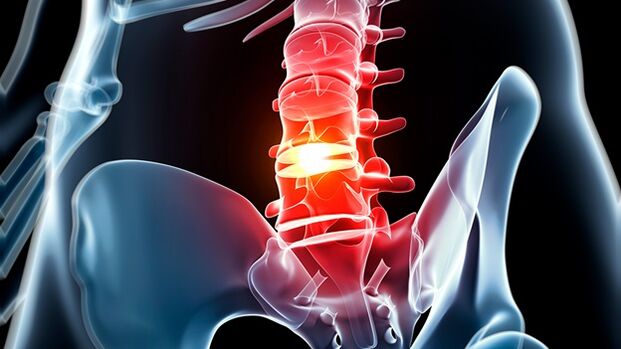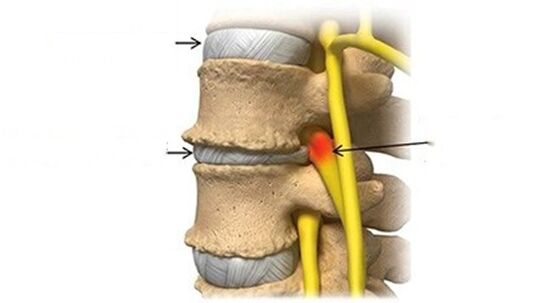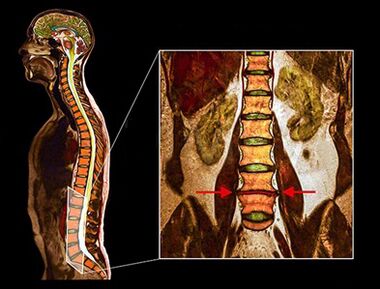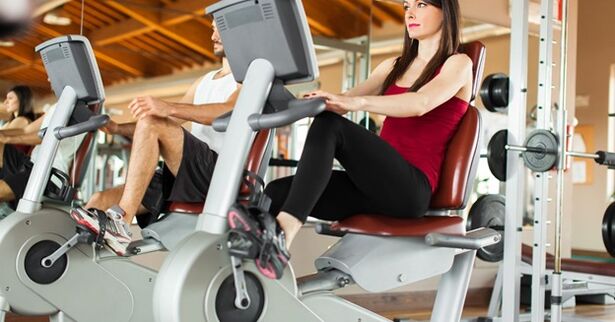Osteochondrosis (degenerative disc disease) in the lumbar spine or lower back is caused by a change in involutionary in the disc, leading to lower back pain.
The intervertebral disc is a hard, fibrous structure that acts as a ligament between the vertebra, absorbs the stroke and provides the absorption of the spinal cord.The disc is elastic, but is strong enough to facilitate movement, such as the body's tilt, forward, back or to the side.
Although its name, osteochondrosis is not considered a true disease and symptoms over time, as a rule, it does not worsen.Discs, as well as all body structures, degradation, and disk degeneration develop in everyone, as part of the process of spreading.
Characteristics of osteochondrosis are a gradual decrease in symptoms when the spine begins to stabilize.Lumbar spinal osteochondrosis treatment focuses on minimizing pain, stabilizing the spine and improving or maintaining mobility.
Symptom

Most cases of manifestations of lumbar spinal osteochondrosis have little back pain, which from time to time strengthen for several days or more.
Symptoms may vary -different, but most features include:
- Moderate back pain.Pain in damaged discs is the most common symptom of disc degeneration.Pain can spread to the back, thighs and upper thighs.This pain is usually felt as a fool, and intensity can change from light to severe.
- Acute episodes of periodic pain.Back pain can be intensified for several days or weeks, and then return to a simpler level.The outbreak of pain occurs as a degeneration and subsidies as the spine gradually stabilizes.The outbreak of pain can occur suddenly and the manifestation of pain often results in decreased mobility.
- Local pain.The lower back surrounding the degeneration disc can be sensitive to touch.Local pain is caused by inflammation and muscle tension in the area of the disc damaged by degeneration.
- Pain in the legs.Neurological symptoms, including numbness, weakness or sharp, shooting in the back, hips and / or back of the legs, can be felt if the height of the disc is significantly reduced, and the condition for the compression of the nerve root.Pain in the foot with lumbar spinal osteochondrosis usually does not fall below the knee.
- A sense of weakness or instability -can occur with significant disk weakness and the patient creates that the lower back does not fully perform its function.
In addition, pain can increase or decrease when performing certain movements or pose, such as:
- It hurts in the seat.Sitting for a long time often results in increased back pain and stiffness and decrease after appearing or changes in position.
- Strengthen pain by tilt or spin.Promoting the spine and tilt forward, back or sides can cause intense, pain in damaged discs.
- Reduces pain while walking or changing positions.When the spine changes position, the pressure on the disc decreases or distributed from the disc to the muscles and joints.Frequent positions, interchanging and sitting, as well as short walks can help reduce stiffness and minimize pain.
Disc degeneration should not cause symptoms of intestinal / bladder dysfunction, fever with back pain, inaccessible weight loss and rapid or intensive abdominal pain.These symptoms show a more serious condition and often require surgical treatment methods.
Symptoms associated
With lumbar spinal osteochondrosis, in addition to back pain, other symptoms associated with disc degeneration may occur.For example:
- The proteins contained in the disc can cause significant inflammation if they come in contact with the surrounding spine structure, and these inflammation can cause lower back muscle cramps, as well as radial pain, with radiation in the hip and on the posterior surface (also called ishias).
- The deterioration of lumbar discs can contribute to the development of lumbar stenosis and / or lumbarthritis osteoarthritis, as well as other conditions in the lower back.
- Dissemination discs can also cause the appearance of lumbar intervertebral disc hernia.Neurological symptoms with disc hernia can be acute and intense.
- Symptoms caused by disc deterioration in the lumbar spine can vary -depending on how fast or completely the disc has degeneration and how it affects the surrounding spine structure.
- Pain for osteochondrosis is usually caused by muscle deformation that supports the spine and inflammation around the structure near the disc.
Causes of lumbar spine osteochondrosis
Osteochondrosis occurs as a result of wearing and disruption of the structure of the disc structure, and the process of degeneration can accelerate the result of injury, general condition, health and lifestyle, and, perhaps, a genetic tendency to the development of pathological processes in the musculoskeletal system.

Osteochondrosis rarely begins with serious injuries, such as car accidents.It is more likely that the onset of the degenerative process is associated with low disc injuries.
Legal pain associated with lumbar osteochondrosis is usually produced by one or more pathological processes:
- Inflammation, protein from the disc is endangered by the surrounding nerves - both small nerves in the disc itself and the potential nerves go to the legs (sciatic nerves).
- Abnormal micro instability, when the outer ring of the disc, called fibrous rings, wear and cannot absorb the power vector on the spine, leading to movement along the vertebral segment.
- For a long time, the pain in lumbar spinal osteochondrosis eventually decreased, and did not get worse.The release of this pain occurs because the disc is completely damaged by degeneration no longer has an inflammatory protein (which can cause pain) and the sleep disc passes a stable position, eliminating the movement of the micro that causes pain.
Risk factors
Lifestyle factors that affect general health conditions can affect the intervertebral disc.Degenerative disc disease risk factors (osteochondrosis) include:
- Family history of back pain or skeletal disorders and muscles
- Excessive load on the lower back, due to playing sports, or work nature
- Long static load on disc due to prolonged chair and / or poor posture
- Lack of disc support due to weak back muscles
- Obesity
- Smoking or any form of nicotine use
Disc degeneration is part of the aging of the body, but not everyone is suffering from pain or special symptoms.Symptoms tend to occur in case of instability, muscle tension and, possibly, nerve root irritation.
Diagnostics
- The history of the disease includes a detailed study of the symptoms in the patient, their intensity and the relationship of pain with the burden or position of the body.Information on normal physical activity, sleep habits and past injuries are also required.
- Physical examination is necessary to study the various movements and conditions of the muscle corset.The presence of painful areas in palpation or physical abnormalities is also determined.In addition, neurological tests are conducted to determine the neurological deficit.
- The above diagnostic methods are usually sufficient for diagnosis of osteochondrosis, but accurate diagnosis requires the use of visualization method.
- Ct
- Radiography
- MSCT
- Pat
- MRI - This diagnostic method allows you to explain the degree of degeneration, the presence of bone fractures, stenosis disc hernia.Often MRI studies are needed in preparation for surgical treatment to accurately determine the location of the degeneration disc and plan surgery.

Studies have shown that MRI outcome with moderate or significant disc deterioration was found when scanning the patient, either with severe and minimal pain or a lack of pain.In addition, many painful conditions may not appear in MRI.For this reason, the diagnosis cannot be made exclusively based on visualization outcomes, and diagnosis verification is only possible based on the entire clinical and instrumental examination method.
Treatment
The initial method of treating lumbar spinal osteochondrosis and pain manifestations usually include the following combinations:
- Overcoming painkillers They can reduce inflammation, which contributes to discomfort, stiffness and nerve root irritation.
- Prescription Painkillers.In severe pain, muscle relaxants or narcotic painkillers may be prescribed.These drugs are commonly used to treat intensive pain, which is expected to last for more than a few days or weeks.These drugs can cause addiction and cause serious side effects, so they should be used carefully.
- Heat and ice.The use of heat in the bottom improves blood circulation, which reduces muscle cramps and tension and increases mobility.Ice packages can reduce inflammation and relieve moderate pain.It is useful to use heat before physical exercise to relax the muscles and use ice after physical activity to minimize inflammation.
- Manual therapy. Manipulation performed by experts is a popular method for controlling pain in back pain.Practicing doctors, manual therapists, using their hands to affect various areas of the body to reduce tension in the muscles and joints.It has been found that manipulation is an effective step in reducing temporary pain, and in some cases it is as effective as drug therapy.
- Massage.Exposure to massage methods can reduce tension and cramps in the back muscles, reduce pressure on the spine and relieve pain.In addition, therapeutic massage can improve blood circulation, ensuring the delivery of nutrients and oxygen to the tense muscles.
- An epidural steroid injection.The introduction of steroids into space surrounding the spine can reduce the impulses of pain, as well as inflammation.Steroid injections can be used in combination with physical therapy programs to relieve pain during physical training and recovery.As a rule, the steroid epidural injection allows to reduce pain by several weeks to one year.
In many cases, for effective anesthesia, a combination of treatment methods is required.The process of experimentation and error, as a rule, is necessary to choose the treatment that turns out to be the most effective.
Long bed breaks are not recommended, and, as a rule, immobilization may be with severe pain for a short period of time, as lack of physical activity can lead to muscle weakness and normal support of the spine.
Exercise therapy and activity modification

To maintain healthy mobility of the spine, physical training is required.Effective exercise programs for lumbar spine should include:
- Exercises to stretch the back, hip and pelvis muscles, as well as damaging muscles.This muscle seal increases pressure on the lumbar spine and contributes to the development of lower back pain.
- Power exercises on the back and lower abdomen allow you to maintain good posture and better to maintain the spine.Training programs to strengthen muscle may include individual training therapy programs, lumbar spine dynamic stabilization, tai-chi, pilates or others.
- Aerobic exercises with low load levels, which increase the frequency of heart contraction, increase blood circulation and provide nutrients and oxygen, which is needed to restore body tissue.For example, it can walk, swim and aerobic water.
Physical training programs are usually adapted in each case, depending on the general health condition, severity of pain and personal preference.
In addition, small adjustments to daily activities -day (lifestyle modification) can effectively soften pain.For example, wearing a corset when lifting weights or avoiding rotating when lifting weights, can prevent increased pain due to excessive load on the disc.The use of ergonomic chairs and orthopedic mattresses can also increase posture and reduce the load on the disc.
Surgical
Lumbar spinal osteochondrosis surgery is required in cases where conservative treatment for 6 months is incompetent.Surgical treatment for osteochondrosis is always selective, which means that the patient himself decides whether the surgery should undergo.
It is recommended to take into account all factors before deciding on the operation for osteochondrosis, including the duration of recovery, pain treatment during recovery, and spinal recovery.
The merger of the vertebrae
Standard surgical treatment of lumbar spinal osteochondrosis is a merger surgery where two vertebrae are spent together.The purpose of spondylodeza is to reduce pain and eliminate instability in the spinal motor segment.
All spinal cord operations are as follows:
- The damaged disc is completely removed from the intervertebral space (diskoctomy).
- Stabilization is performed using bone and / or tool transfer (implants, plates, stems and / or screws).
- Then the vertebrae fuse, forming a solid and non -moving structure.Battle occurs within a few months after the procedure, and not during the operation itself.
After surgery, wearing a corset, taking analgesic is prescribed.Exercises are connected very carefully, taking into account the individual characteristics of the patient and the level of tissue regeneration.Complete recovery after the merger may take up to a year until the vertebrae develops together.
Replacement of artificial disc surgery
Replacing damaged discs with artificial implants have been developed in recent years as an alternative to mergers.The disc replacement operation consists of completely removing disk damaged by degeneration (diskoctomy), recovery of disk space to natural height and artificial disk implantation.
This procedure is designed to maintain movement in the spine similar to natural movement, reducing the likelihood of increasing pressure on the neighboring spinal segment (a relatively common complication of the spine combination).
Recovery after surgery of disc replacement usually lasts up to 6 months.






















